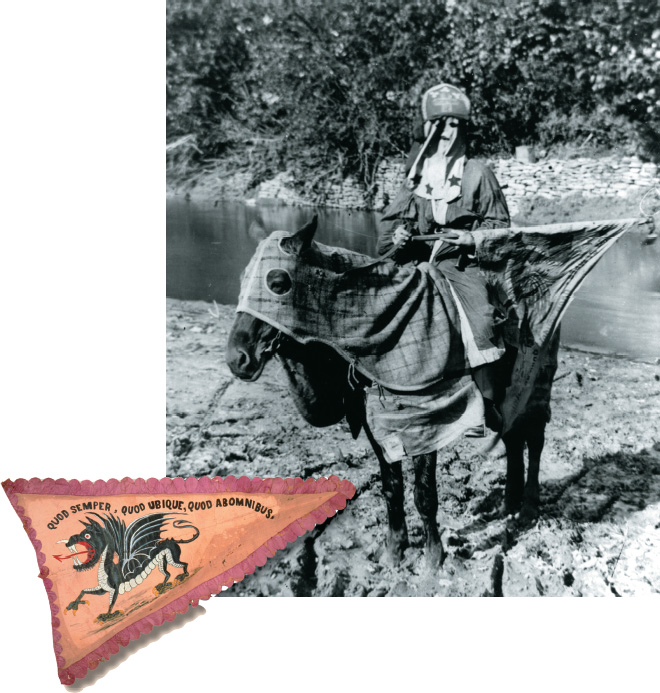1.4.4 HISTORICAL QUESTION: What Did the Ku Klux Klan Really Want?
HISTORICAL QUESTION
What Did the Ku Klux Klan Really Want?
In 1866, six Confederate veterans in Pulaski, Tennessee, founded the Ku Klux Klan for fun and fellowship. But by 1868, when congressional reconstruction went into effect, the Klan had spread across the South, and members had shifted to more serious matters.
According to former Confederate general and Georgia Democratic politician John B. Gordon, the Klan owed its popularity to the “instinct of self-preservation…the sense of insecurity and danger, particularly in those neighborhoods where the Negro population largely predominated.” Everywhere whites looked, he said, they saw “great crime.” Republican politicians marched ignorant freedmen to the polls, where they blighted honest government. Ex-slaves drove overseers from plantations and claimed the land for themselves. Black rapists made white women cower behind barred doors. It was necessary, Gordon declared, “in order to protect our families from outrage and preserve our own lives, to have something that we could regard as a brotherhood — a combination of the best men of the country, to act purely in self-defense.”

Behind the Klan’s high-minded and self-justifying rhetoric, however, lay another agenda. It was revealed in their actions, not their words. Klansmen embarked on a campaign to reverse history. Garbed in robes and hoods, they engaged in guerrilla warfare against free labor, civil equality, and political democracy. They aimed to terrorize their enemies — ex-slaves and white Republicans — into submission. Changes in four particular areas of southern life proved flash points for Klan violence: racial etiquette, education, labor, and politics.
The Klan punished those blacks and whites who broke the Old South’s racial code. The Klan considered “impudence” a punishable offense. Asked to define “impudence” before a congressional investigating committee, one white man responded: “Well, it is considered impudence for a negro not to be polite to a white man — not to pull off his hat and bow and scrape to a white man, as was done formerly.” Klansmen whipped blacks for speaking disrespectfully, refusing to yield the sidewalk, and dressing well. Black women who “dress up and fix up like ladies” risked a midnight visit from the Klan. The Klan sought to restore racial subordination in every aspect of private and public life.
Klansmen also took aim at black education. White men found the sight of blacks in classrooms hard to stomach. Schools were easy targets, and scores of them went up in flames. Teachers, male and female, were flogged, or worse. Klansmen drove northern-born teacher Alonzo B. Corliss from North Carolina for “teaching niggers and making them like white men.” In Cross Plains, Alabama, the Klan hanged an Irish-born teacher along with four black men. Planters wanted ex-slaves back in the fields, not at desks. In 1869, an Alabama newspaper announced that the burning of a black school should be “a warning for them to stick hereafter to ‘de shovel and de hoe,’ and let their dirty-backed primers go.”
Planters turned to the Klan as part of their effort to preserve plantation agriculture. An Alabama white admitted that in his area the Klan was “intended principally for the negroes who failed to work.” Hooded bands “punished Negroes whose landlords had complained of them.” Sharecroppers who disputed their share at “settling up time” risked a visit from the night riders. It was dangerous for freedmen to consider changing employers. “If we got out looking for some other place to go,” an ex-slave from Texas remembered, “them KKK they would tend to Mister negro good and plenty.”
Above all, the Klan terrorized Republicans. Klansmen became the military arm of the Democratic Party. They drove blacks from the polls on election day and assaulted Republican officeholders. Klansmen gave Andrew Flowers, a black politician in Chattanooga, a brutal beating and told him that they “did not intend any nigger to hold office in the United States.” Jack Dupree, president of the Republican Club in Monroe County, Mississippi, a man known to “speak his mind,” had his throat cut and was disemboweled while his wife was forced to watch.
Political violence reached astounding levels. Arkansas experienced nearly three hundred political killings in the three months before the fall elections in 1868. Louisiana was even bloodier, suffering more than one thousand killings in the same year. In Georgia, the Klan murdered three scalawag members of the legislature and drove ten others from their homes. As one Georgia Republican commented after a Klan attack: “We don’t call them [D]emocrats, we call them southern murderers.”
It proved hard to arrest Klansmen and harder still to convict them. “If a white man kills a colored man in any of the counties of this State,” observed a Florida sheriff, “you cannot convict him.” Federal intervention — in the Ku Klux Klan Acts of 1870 and 1871— signaled an end to much of the Klan’s power but not to counterrevolutionary violence in the South. Other groups continued the terror in the cause of white supremacy.
Thinking about Beliefs and Attitudes
What changes during Reconstruction particularly provoked the Klan? Why do you think these issues were so important to Klansmen?
Why did Klansmen believe that their actions were justified? Why do you think they hid their identities?
What southern traditions did the Klan seek to perpetuate?